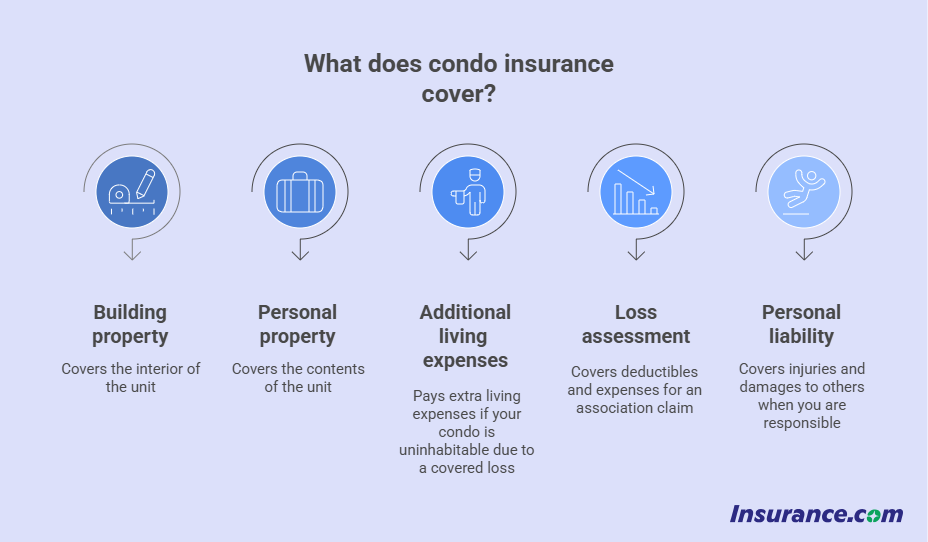- What is HO-6 condo insurance?
- How much condo insurance is enough?
- How much dwelling coverage do I need for a condo?
- How much personal property coverage do I need for a condo?
- How to determine how much coverage you need for your condo
- What does condo insurance cover?
- Calculating how much condo insurance you need: Step-by-step
- Make sure you have enough condo insurance
- Methodology
- FAQ: How much condo insurance do I need?
What is HO-6 condo insurance?
An HO-6 policy is a home insurance policy specifically for condominiums. Unlike standard HO-3 home insurance, HO-6 insurance only covers things inside your unit.
The biggest difference between HO-3 and HO-6 policies is that a homeowners insurance policy provides coverage for the structure itself. HO-6 condo policies don’t include that coverage since the structure is covered by the condo association. However, some portions of the unit's interior may be covered by your policy, so find out how much dwelling coverage you need. An HO-6 condo policy also includes liability coverage.
How much condo insurance is enough?
You need enough condo insurance to cover:
- All of your personal property, including high-value items
- Any parts of the unit for which you're responsible. It's best to accurately calculate the value of your property and the building property you're responsible for insuring. Check with your condo association to find out what type of building property coverage you need, if any.
- Your assets in a lawsuit. The standard condo insurance policy typically includes $100,000 in liability coverage, but experts recommend having at least $300,000.
EXPERT TIP: As a rule of thumb, you should have 20% of the unit's value in building property coverage and $300,000 in liability coverage.
If your condo is subject to bare walls coverage, assigning a replacement value to the interior can be challenging because the value of your individual condo is partially based on the common features – such as the building exterior, as well as a swimming pool and other amenities.
The exact dollar amount of coverage you need also depends on other factors, such as:
- Construction costs in your area
- The type of materials used in your condo
- The value of your personal possessions
If you're struggling to put a dollar figure on the amount of coverage you need, talk to your insurance agent. Powell says it is always better to buy too much coverage rather than not enough.
How to estimate your condo insurance needs: Quick checklist
- Review your HOA's insurance policy to determine what type of coverage you need
- Calculate building property coverage limits, considering upgrades and mortgage requirements; 20% of the condo's value is a good rule
- Inventory your personal property and estimate its value; add extra coverage for high-value items
- Decide how much liability insurance you want; experts recommend $300,000
- Choose add-on coverages like water and sewer backup coverage
Condo insurance deductibles
Rather than cutting corners on coverage, consider choosing a higher deductible, which can lower your premium. The deductible is what you pay toward damages when you file a claim.
Deductibles apply to the personal property coverage portion of your policy. You typically have a range of deductible amounts from which to choose.
Actual cash value versus replacement value
One typical mistake condo owners make is buying coverage that reimburses the actual cash value of their belongings instead of a policy that covers the replacement cost. Actual cash value typically means your belongings are covered for their replacement cost minus depreciation. Depreciation is the decrease in an item’s value due to its age, condition or other factors. Replacement value means your belongings are covered for the amount it would take to replace them at the time of the claim.
Loss assessment coverage
This coverage reimburses you if the condo association charges a one-time special assessment fee to unit owners to cover costs that exceed the coverage limits of the association's master policy.
Loss assessment coverage is part of most condo policies but typically provides just $1,000 in coverage. If this is the case with your policy, Powell urges you to purchase additional coverage. Special assessments sometimes can soar into thousands of dollars.
"Most people should buy $5,000 or $10,000 at a minimum," Powell says.
Liability coverage
Condo policies include liability coverage, which protects you if you are responsible for injuries or property damage to someone else.
"Many times, it will be a minor injury," she says. "But other times, you may be sued, and liability insurance will provide coverage for you," says Lori Conarton, spokesperson for the Insurance Alliance of Michigan.
The standard condo liability limit is $100,000, but experts recommend at least $300,000.
"Lawsuits can be very expensive," Conarton says. She says the average judgment in slip-and-fall cases is $100,000, and the average cost to defend a liability lawsuit is $50,000.
Judgments could go much higher if somebody is severely injured or even killed.
"Without liability insurance, the results of a lawsuit could be devastating financially to you," Conarton says.
How much dwelling coverage do I need for a condo?
Dwelling coverage for a condo differs from a homeowners insurance policy. Usually called building property coverage, you need enough to cover whatever portion of the interior of your unit isn't covered by the HOA master policy. However, a good rule of thumb is to buy insurance at 20% of the condo's value.
People ask
Does dwelling coverage (Coverage A) cover accidents?
Yes. Condo insurance covers accidental damage to your home.
How much personal property coverage do I need for a condo?
You need enough personal property coverage to cover all of your personal belongings. A home inventory can help you to estimate how much coverage you should buy. Be sure to include everything, not just high-value items, as replacing everything you own adds up fast.
How to determine how much coverage you need for your condo
Before buying condo insurance, review your condo association policy to find out what the condo association's master policy covers and what the condo owner's policy (your policy) needs to cover.
Here are the three different types of condo association policies and the coverage they offer -- from the most protection for the unit owner to the least protection:
All-in and all-inclusive. Protects all individual units’ exterior and interior surfaces, including fixtures, installations, and additions. The individual condo owner is still responsible for personal property.
Special entity. Covers nearly all of the condo structure, which includes original fixtures in units. This coverage doesn't include structural improvements or unit additions. The condo owner is responsible for personal property coverage.
Bare walls in and wall studs in. Covers only the bare structure. You will need to insure all of your condo’s interior contents, including bathroom and kitchen fixtures and countertops, as well as your personal property.
Knowing what the master policy covers can help you purchase the right individual condo insurance policy coverage, says Doug Foulks, personal lines products manager at Van Wert, Ohio-based Central Insurance Companies.
When looking over your policy, check for phrases such as “all in, “all-inclusive,” “special entity, “ “bare walls in” and “wall studs in.” These phrases tell you the level of coverage that the HOA policy provides.
"Sometimes they are easy and straightforward and other times they can be complex, where you almost have to be a lawyer" to understand them, Foulks says.
What does condo insurance cover?

A standard condo insurance policy covers:
- Building property coverage. Condo insurance doesn’t have dwelling coverage like a standard homeowners insurance policy. Instead, the coverage is usually called building property coverage (some policies may still use the term dwelling). This covers the parts of the structure for which you are responsible.
- Personal property coverage. Anything that you take with you when you move is covered under personal property coverage. Keep in mind standard condo insurance has limits on certain valuables, such as fine art, antiques, jewelry, and electronics. So, you might need to purchase an endorsement or "floater" to provide additional coverage for certain items.
- Additional living expenses or loss-of-use coverage. Many condo policies also provide additional living expenses coverage in case your condo is damaged to the point that it is temporarily uninhabitable. Additional living expense coverage kicks in to help pay extra living expenses like hotels and food while you can’t use your home.
- Loss assessment coverage. Loss assessment coverage helps pay for condo association-related incidents. "Depending on the type of loss, the condo association can go back against the condo owners [to cover a loss] and everyone would have to pay their part," Foulks says.
- Personal liability coverage. Condo insurance also provides personal liability protection. That means you will be covered for injuries or damage you cause to someone else. Make sure you select liability limits that are enough to protect your assets. Liability insurance often ranges from $100,000 to $500,000. You may want to explore a personal liability umbrella policy if the liability limits aren't high enough.
Calculating how much condo insurance you need: Step-by-step
You must decide how much condo coverage is necessary to protect your belongings and interior features, such as wood floors, kitchen cabinets, and fixtures. Here's how.
- Take stock of the interior items in your condo unit, including furniture, clothing, and electronics. Don’t forget to record any high-value items like jewelry or art.
- Calculate how much building property coverage (dwelling coverage) you need based on what your HOA covers. There are two ways to calculate building property coverage: percentage of the condo's value (20% is standard) or based on square footage multiplied by average building cost in your area.
- Consider replacement cost coverage for personal property; it's more expensive than cash value coverage, but you'll be glad you paid the extra if you suffer a major loss. "People tend to underestimate the cost to replace all the stuff," Schaum says. "We are not talking about what it's worth today, but what it costs to replace it new."
- Choose liability coverage. If your assets are more than $500,000, you may want to look into an umbrella policy.
- Finally, it might make sense to add some optional condo insurance coverage, such as:
- Water backup coverage. This protects you in case a sewer or drain backup causes water damage to your unit.
- Additional coverage for valuables. You may be able to purchase a floater that will give you higher coverage limits for jewelry, collectibles, and other expensive items.
- Flood insurance. Like regular homeowners insurance, a regular condo insurance policy doesn't protect you against flood damage. You will have to buy a separate flood insurance policy.
Make sure you have enough condo insurance
It’s not uncommon for condo owners to be underinsured. Take the time to carefully calculate how much coverage you need, particularly when it comes to your personal property. It’s easy to underestimate how much it would cost to replace everything you own.
Your condo is your home, and you want to protect it properly, so ensure you understand your needs before buying a policy.
Methodology
Insurance.com commissioned Quadrant Data Services to field rates for condo insurance in every state with personal property limits ranging from $40,000 to $100,000, a deductible of $1,000, and $300,000 in liability coverage.
Our condo insurance base averages are use the following parameters:
- $60,000 in personal property coverage
- $300,000 in liability coverage
- $1,000 deductible
- Good credit
FAQ: How much condo insurance do I need?
Is condo insurance cheaper than home insurance?
Yes. Condo insurance premiums are than less than homeowners insurance because it doesn't cover the entire structure.
What is the rule of thumb for condo insurance?
There are no hard and fast rules when calculating condo insurance needs since every condo is a little different and association coverage varies. However, when calculating how much dwelling coverage (building property coverage) you need, a good rule of thumb is to insure it for 20% of the condo’s total value.
Of course, you might need to consider upgrades and high-end fixtures to ensure your numbers are accurate.
Is condo insurance required?
While condo insurance is not required by law, if you have a mortgage on your condo, your lender will most likely require condo insurance. This helps to ensure their investment in the condo is protected at least until you've paid them back in full.
It is also common for HOAs to require certain levels of condo insurance.
Does condo insurance cover theft?
Yes. Check your policy to see if there are any exclusions. For example, some high-value items like expensive jewelry may not be covered without an endorsement.
Why should you buy condo insurance?
You should consider buying condominium insurance because it provides coverage for the interior contents of your unit and offers protection in case of a liability claim due to an accident involving a guest or visitor.
Your condominium association has its own coverage, and it will cover the building as well as shared property and liability coverage for the association, but not the things inside your condo. Condo insurance protects you.




